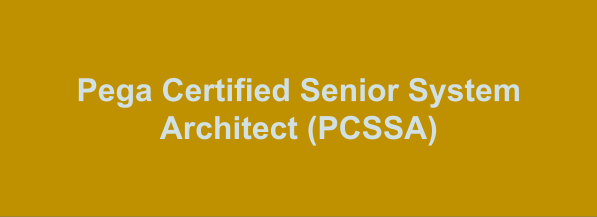The Senior System Architect mission continues the journey to increase your knowledge of application development on Pega Platform™. The modules in this mission focus on tasks that a senior system architect performs to develop a Pega application.
Pega Certified Senior System Architect (PCSSA)
The Pega Certified Senior System Architect (PCSSA) certification validates the ability to use Pega to design and build for reusability across multiple lines of business. It includes applying best practices, understanding application debugging and performance tuning, and addressing security/access requirements in an application. The PCSSA version 8.6 exam includes scenario questions, multiple choice questions and drag/drop items. If multiple answers are required, the text states how many responses are needed. Pega Certified System Architect (P/CSA) certification in any version is required to begin the PCSSA certification program.
Pega PCSSA Exam Summary:
| Exam Name | Pega Certified Senior System Architect |
| Exam Code | PCSSA |
| Exam Fee | USD $175 |
| Exam Duration | 90 Minutes |
| Number of Questions | 60 |
| Passing Score | 70% |
| Format | Multiple Choice Questions |
| Books / Trainings | Class Schedule |
| Sample Questions | Pega PEGAPCSSA87V1 Exam Sample Questions and Answers |
| Practice Exam | Pega Certified Senior System Architect (PCSSA) Practice Test |
Pega Senior System Architect Syllabus Topics:
| Topic | Details | Weights |
| Application Development | - Define the Enterprise Class Structure - Create an application with the New Application wizard - Understand the rule resolution process; Adjust rule availability - Identify how circumstancing affects application behavior - Circumstance rules on a single variable or multiple variables - Differentiate between a queue processor and a job scheduler - Identify the role and elements of activities in case processing - Automate actions when a property value changes - Promote rule reuse with relevant records - Identify the role and impacts of application versioning; Use of ruleset skimming - Configure and validate application rulesets - Branch rulesets for parallel development - Migrate an application; use of product rules |
28% |
| Case Management | - Differentiate between work groups, work queues, and organizational structures - Configure parallel processing for cases - Manage concurrent case access; Locking strategies - Configure flow action pre- and post- processing - Extend service-level agreement configurations |
15% |
| Data and Integration | - Validate data against a pattern - Identify use cases for Keyed Data Pages - Exchange data with other applications - Manage integration settings - Address integration errors in connectors - Expose an application with a web service |
19% |
| User Experience | - Create and customize Pega Web Mashups - Configure Pega Web Mashup authentication |
5% |
| Reporting | - Design reports with multiple sources; associations and joins | 5% |
| Performance | - Measure System Performance; use of performance-related tools - Debug system performance - Review log files: Distinguish system events and performance events |
7% |
| Security | - Distinguish between role-based, attribute-based, and client-based access control - Organize and manage case attachments - Secure data with data encryption |
16% |
| Mobility | - Differentiate between the delivery options for mobile devices - Design applications for mobile use; use of certificate sets |
5% |





0 comments:
Post a Comment